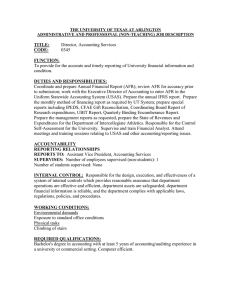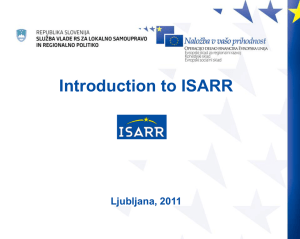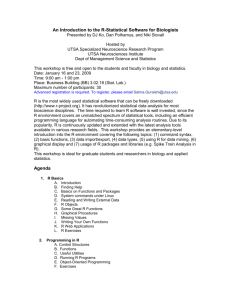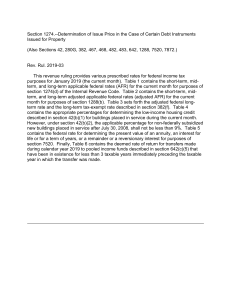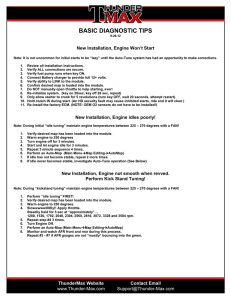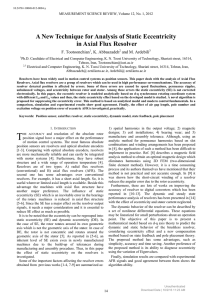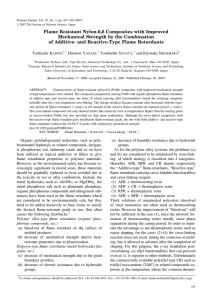Document 17796019
advertisement
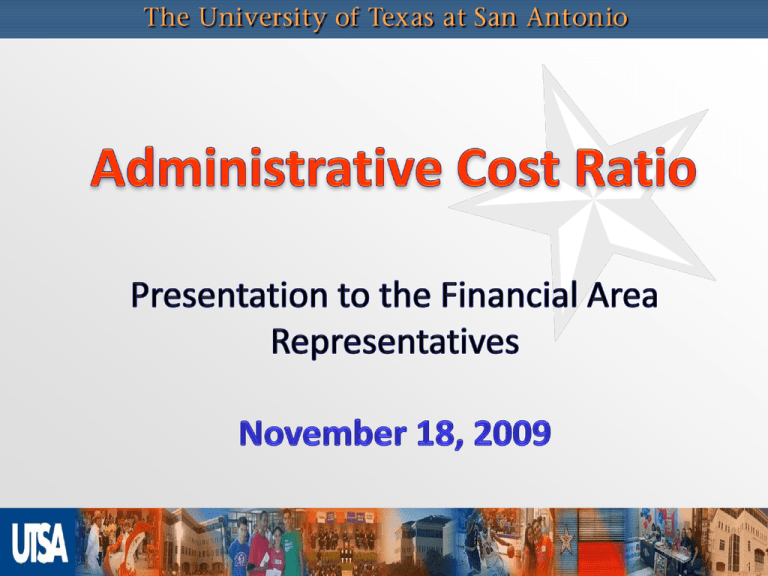
Institutional Support Expenditures Total Operating Expense divided by According to the Legislative Budget Board: “provides an indicator of the proportion of operating budget being spent on administrative costs.” 2 Institutional Support is a functional category defined by NACUBO (National Association College & University Business Officers) used to allocate costs between higher education activities. 3 Institutional Support includes: Executive Management – President, VPs & their staff including operations related to planning & legal Fiscal Operations – should not include bad debt expense General Administration– HR, Purchasing, etc. Administrative Information Technology Public Relations/Development 4 Instruction – costs directly related to instructional mission (includes department chairs). Academic Support – includes dean’s offices & library, museums, academic computing & advising. Research– includes expenses for activities specifically organized to produce research whether internal or externally funded. Public Service – non instructional activities to external groups. Includes conferences, institutes, consulting & general advisory services. 5 Student Services – costs that have the primary purpose of contributing to students’ emotional and physical well being and intellectual, cultural & social development (outside the context of the formal instructional program.) Includes admissions & records, student IT, student health, counseling & career guidance, financial aid administration. Does not include intercollegiate athletics programs as those must be identified as an Auxiliary Enterprise by Texas law. 6 Operation & Maintenance of Plant – includes administrative costs, building maintenance, custodial, utilities, landscape / grounds, repair & renovation, security & safety (police, disaster preparedness, environmental health & safety, etc.), logistical services (central receiving, stores) and facilities related IT. Scholarships & Fellowships Auxiliary Enterprises– self supporting entities to furnish goods or services to students, faculty, staff or incidentally to the general public; includes all related administrative expenses. 7 Institutional Support Expenditures Total Operating Expense (FY09 Annual Financial Report) $40,437,657 ____________ = 11.24% $363,087,491 UTSA 5 Year Administrative Cost Trend AFR 2005 AFR 2006 AFR 2007 AFR 2008 AFR 2009 28,925,000 32,996,000 30,657,000 31,505,000 40,816,000 256,385,000 277,752,000 298,937,000 328,230,000 363,087,000 11.3% 11.9% 10.3% 11.2% 11.2% FY96 (10.4%) FY97 (11.6%) FY03 (11.2%) FY04 (11.7%) 9 Comparative Administrative Cost Trends AFR 2006 AFR 2007 AFR 2008 AFR 2009 11.9% 10.3% 11.2% 11.2% UT Dallas 9.6 8.5 9.8 9.1 UTEP 8.6 7.5 7.7 7.5 (est) UT Pan Am 8.2 9.7 9.6 10.9 UT Arlington 8.3 8.7 8.0 DNR UT Tyler 15.4 13.2 12.7 DNR UT Austin 6.1 5.7 5.1 DNR UTSA A small institution will usually have a higher institutional support percent of program expense than a large comprehensive institution. 10 5 Yr Comparison by Program UTSA FY05 FY06 FY07 FY08 FY09 5 Yr Chg Instruction 34% 33% 33% 33% 30% -4% Research 7% 9% 8% 8% 10% 3% Academic Support 7% 8% 9% 9% 10% -1% Public Service 6% 6% 5% 5% 5% 2% Student Services 8% 8% 8% 9% 7% -1% Institutional Support 11% 12% 10% 10% 11% 0% O&M of Plant 9% 10% 10% 12% 10% 1% Scholarships 9% 7% 8% 8% 8% -1% Depreciation 8% 7% 8% 8% 9% 1% 11 Higher education is under scrutiny for spending and considered to be inefficient. Governor Perry has ordered a review of highereducation spending executive order calls for a comprehensive review of costefficiency in the state's public higher-education system. The order lists a dozen areas to be considered, including faculty workload, basing state spending on student course-completion rates, and consolidating or eliminating academic programs. To demonstrate a goal of lowering administrative costs is important when we are asking students to increase tuition rates over the next 2 years. 12 UTSA’s LAR performance goal was 10%. We exceeded that by 1.2% What can we do to lower our ACR? Assure we are using the account that correctly represents the functional NACUBO program for ALL expenditures. 13 Fill vacant faculty positions & improve the ratio of T/TT to NTT Allocate administrative costs to Auxiliary Enterprises Increase extramural funding – sponsored programs & gifts 14 Governor Perry’s Executive Order RP73 on Higher Education Cost Efficiency http://governor.state.tx.us/news/executiv e-order/13573/ Directs Coordinating Board to review and offer recommendations for cost efficiencies in higher education 16 Included in the review: State funding based on student course completion Restructuring financial aid to improve efficiencies & to provide aid to students who work hard to academically prepare for college Academic program consolidation & elimination of programs that produce few graduates 17 Included in the review, continued: Faculty Workload Articulation agreements between 2 and 4 yr institutions Distance Learning Alternatives to creating new campuses Course redesign to improve quality & reduce instructional costs for more courses 18 Included in the review, continued: Cooperative, cross-system contracting & purchasing Space utilization Energy use Cost of instructional materials Review of cost efficiencies in other states & nations 19 Executive Vice Chancellor Scott Kelley for Business Affairs at UT System is the sole UT Representative: http://www.utsystem.edu/BUS/vice_chancellor.htm Report to be submitted to Governor, Legislature & institutions by November 1, 2010 Assumed to supplant HB4149 report: http://www.legis.state.tx.us/tlodocs/81R/senateamend /pdf/HB04149A.pdf 20 Continued scrutiny of tuition increases Formula Advisory Committee work Interim House & Senate committee studies 2010 Elections & Consequences 21 State economic & budget condition Stimulus funds not available ($338M for Higher Ed) For UTSA this means: $3.53M $1.87M $4M $0.5M Formula Funding ($1.76M – 1 yr impact) Higher Ed Incentive Funds SALSI P-16 Council Structural deficit continues to grow ($12-15B) Sales Tax Receipts down double digits (-12.8% Sept 09 as compared to Sept 08) 22 Rainy Day fund May have $5B against the projected $12-15B deficit? Repeat of 2003 or worse? Some discussion about a mid biennium budget cut Expenditure reductions of 10%? Impacts to Budget Planning 23 Higher Education Funding Needs Maintain formula funding (backed with ARRA money in the prior biennium) TRBs or some form of capital construction support Funding for UT Austin Continuation of National Research University Initiative 24 The Chancellor, under the direction of the Board of Regents, is encouraging each President to redirect resources towards: High priority mission activities Strategic competitive investments; and Reserves in preparation for potential future financial shortfalls 26 1. Consider Scope and Mission – less effective activities may need to be reduced or eliminated 2. Understand the Rationale – reasons should be soundly developed and communicated widely 3. Transparency – decisions and actions must be clear and communicated widely 4. Examine the entire budget rather than budgeting at the margin 27 5. Focus – separate the budget not available for redistribution; while resources from other areas of the budget may not be redistributed, any subsidies to those activities should be identified and discussed. 6. Prioritization 28 7. Revenue – new revenue opportunities are less predictable (and won’t necessarily result in additional discretionary income) 8. Tracking & Measurement 9. External Benchmarks 10. Flexibility 11. Decision Level 29 12. Real v. Theoretical Reallocations – make identification of reallocation strategies reality versus an exercise. 13. Administrative & Academic Overhead – thorough review of non-mission specific activities & expenditures. Targeted reduction in admin OH which do not impede critical mission activities should be identified & communicated. 30 14. Efficiency & Productivity 15. Reallocation Targets – customized to each unit and not across the board; unit should understand the need and amount required; unit should benefit in some way from the reallocation. 16. Multi-year Plan 31
